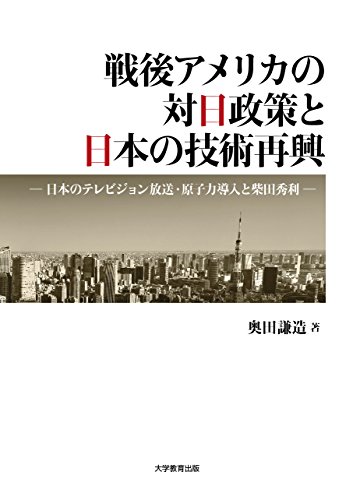3 0 0 0 OA 冷戦期アメリカの対日外交政策と日本のテレビジョン放送導入
- 著者
- 奥田 謙造
- 出版者
- 日本科学史学会
- 雑誌
- 科学史研究 (ISSN:21887535)
- 巻号頁・発行日
- vol.46, no.241, pp.1-13, 2007 (Released:2021-08-11)
The plans for TV broadcasting emerged in Japan when Japan and the US began to negotiate a peace. There were two institutions in Japan that promoted TV broadcasting : NHK, a public radio broadcasting station, and Yomiuri Shinbun, a private daily owned by Shoriki Matsutato. At that time the US was looking for new allies and new ways to block the spread of communism. Then American politicians such as Senator Karl Mundt came to understand that television was a useful tool of psychological warfare against communism. When Hidetoshi Shibata, one of Shoriki's best confidants, found a news report of Mundt's "Vision of America " proposal in the US Senate Congress, he thought that it was a good opportunity for giving a push to a scheme for a new Japanese TV broadcasting. Shibata visited the US in April 1951, met Mundt and others, and asked for their support to Yomiuri's plan. Soon after that Shoriki established Nippon Television Network Corporation (NTV), and invited American TV consultants to Japan. They argued that the Japanese TV system should adopt the American TV standards. In September the Sun Francisco Conference was held for the Treaty of Peace with Japan that led to the termination of the occupation. A report of the US State Department one month after the conference said that Japanese supported the American standards for implementation of the peace treaty and defensive alliance, and by television the Japanese nation would be welded into a democratic ally of the US. With the American standards NHK began its TV broadcasting service in February 1953, and NTV, in August.
1 0 0 0 OA ビキニ事件後の原子炉導入論の台頭
- 著者
- 山崎 正勝 奥田 謙造
- 出版者
- 日本科学史学会
- 雑誌
- 科学史研究 (ISSN:21887535)
- 巻号頁・発行日
- vol.43, no.230, pp.83-93, 2004 (Released:2021-08-12)
- 被引用文献数
- 1
In March 1954 a Japanese fishing vessel, Daigo Fukuryu Mam (Lucky Dragon No.5), suffered from radiation exposure from an American nuclear test at Bikini in the South Pacific. After this incident there appeared both in the US and in Japan a nuclear policy debate that the nuclear energy for peaceful purposes in general, and nuclear reactors in particular should be introduced into Japan in order to counter the communists' propaganda against American nuclear tests and anti-American movements in Japan. The Operation Coordinate Board of the US National Security Council adopted this policy very soon after the Bikini Incident. This was followed a wide range of strategic programs for Japan. Hidetoshi Shibata, then an executive of the Nippon Television Network Corporation, started his press campaign in January 1955 in the newspaper Yomiuri Shimbun together with its owner Matsutaro Shoriki, later the first president of the Japanese Atomic Energy Commission, for promoting nuclear energy for peaceful purposes. Shibata and Shoriki apparently were working together to fight against anti-nuke movements and anti-American activities in Japan. In May they invited John J. Hopkins, President of General Dynamics Corporation, Nobel laureate Ernest Lawrence from the University of California at Berkley, and Lawrence Hafstad, director of the division of reactor development of the American Atomic Energy Commission. Their talks in Tokyo were reported to have impressed many Japanese. This paper shows that Yomiuri Shimbun group's activities were in fact supported by the US government, and were carried out within the framework of the US foreign policy.
- 著者
- 奥田 謙造
- 出版者
- トヨタ自動車株式会社
- 雑誌
- 奨励研究
- 巻号頁・発行日
- 2014-04-01
米国のトルーマン政権は、対ソ連心理戦に関し、1951年に心理戦略委員会を設立し、政治・経済・軍事に関与する「明白」・「機密」の宣伝を推進したのに対し、アイゼンハワー政権は、それまでの心理戦は問題があるとし、1953年6月に「明白」な宣伝を行う作戦調整委員会を設立し、この下に8月に米国文化情報局を設置して、国際情報・文化・教育交流のための博覧会・映画上映・VOA等事業、さらに、12月の「平和のための原子」演説後に、日本への原子力平和利用も進めた。一方、英国も1948年、対ソ連政治戦(米国の心理戦に相当)に関し、外務省内に「明白」・「機密」の宣伝を行う情報研究部を設立し、米国のソ連への直接攻撃に対し、自由主義諸国内の共産主義の影響を阻む調整を図った。米国占領下の日本においては、米国政策の制約を受けながら、戦時中に青春期を犠牲にした若者を対象に政治戦を進めた。しかし、日本の独立後は自由な戦略が可能となった。英国は戦後、経済力は低下し、原子力戦略にも焦りが広がり、米国とは相入れない面もあったが、両国の心理的協調は堅固で有効に作用した。ところで、科学分野で英国は、終戦直後から、軍と学者により原子力の研究開発を進めた。1950年3月に、コッククロフトは「原子力の見通し」論文の中で、原子力と非原子力の区分を行い、原子力平和利用として、第1に原子力発電所建設、第2に増殖炉開発を提唱した。さらに、遡って戦時中の“チューブアロイズ”プロジェクトにおける1943年のケベック協定では、「核開発成果は戦後に英国の民間での利用を認める」、ことも示されていた。以上のような、戦中・戦後の米英の連携から、1955年以後の日本への原子力導入において、米国から先に「原子力平和使節団」が招聘されたにも関わらず、英国は米国の開発遅れを察すると、直ちにコールダーホール型原子炉の導入の態勢を整えられたと考えられる。
